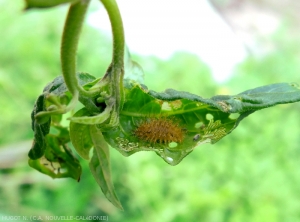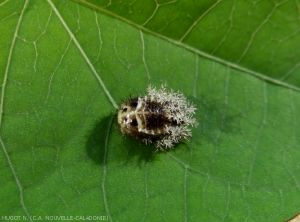Henosepilachna sparsa vigintisexpunctata
Dieke (not Boisduval)
Phytophagous beetle or 26 point beetle
General
- Phytophagous beetle of the family Coccinellidae.
- Easily differentiated from leaf beetles by its club-shaped antennae at their ends.
- All stages of this ladybug from larva to adult are phytophagous.
- Sensitive botanical family (s)
- Affected production areas :
Symptoms, damage
- Symptoms :
- Cut leaves, punctured by the feeding activities of adults and larvae.
- Leaf blade cut between the veins by the young larvae giving the leaves a lacy appearance (often visible on black nightshade) (figure 1).
- Damage generally low impact on the crop.
- Signs : Presence of adults and larvae on affected leaves (figures).
Biology
- Development cycle : comprises 3 larval stages, a pupal stage and an adult stage.
- Eggs laid in bundles (oopplates) under the leaves, they are yellow in color.
- Larvae with globular bodies (figure 1) moving slowly unlike larvae of predatory ladybugs.
- The dark-colored, oval-shaped pupa has white branched appendages on the lower part (Figure 2)
- Adults measuring between 7 and 10mm in length, red-orange in color (figure 3). They have 26 black dots arranged transversely.
- These phytophagous ladybirds are very similar to predatory ladybugs.
Protection
- Given the low level of impact induced by this ladybug, it is generally not useful to put in place protective measures.

Figure 1

Figure 2

Figure 3






